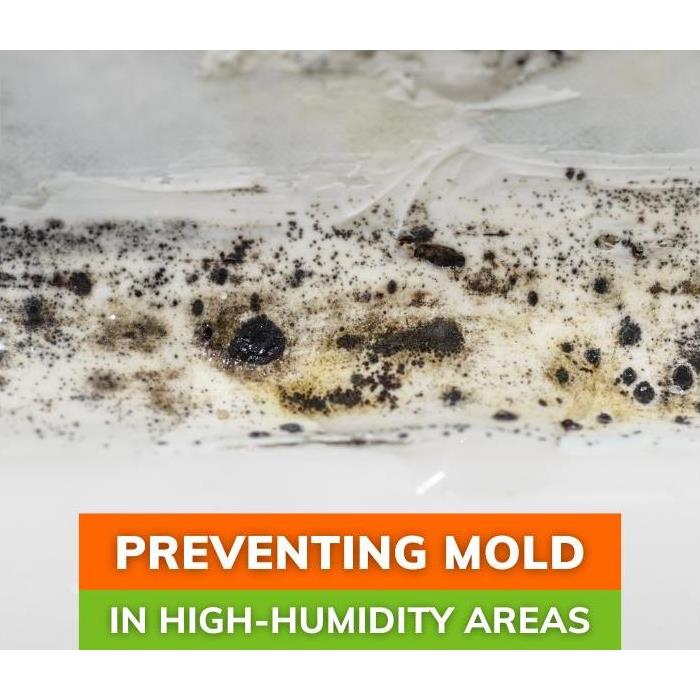How to Prevent Mold in High-Humidity Areas of Your Home
2/5/2025 (Permalink)
How to Prevent Mold in High-Humidity Areas of Your Home
Visible mold is more than an eyesore, as it also presents serious health risks and can lead to destructive and costly home damage. In humid areas, fighting mold requires a multi-pronged approach and ongoing diligence. Some practical and effective strategies can go far towards keeping your home mold-free, protecting your family, and bringing peace of mind.
1. Manage Indoor Humidity
Keeping indoor humidity under control is an essential strategy for preventing mold in humid areas of the home. Monitor humidity levels in different areas of the house by purchasing a reliable hygrometer. Invest in dehumidifiers for high-risk rooms such as bathrooms and basements and run them regularly. Condensation from air conditioning units can build up and become a breeding ground for mold, so ensure the HVAC system is properly cleaned, maintained, and functioning.
Keep doors and windows closed during humid weather to keep overall humidity down inside the home. Moisture can come from various sources, including water leaks, so address them immediately to prevent costly damage and mold.
2. Ensure Adequate Ventilation Throughout the Home
Good airflow is essential in keeping rooms dry and free of mold. When rooms do not have adequate ventilation, moisture remains, creating mold growth conditions. To prevent stagnant humidity, use exhaust fans whenever condensation is present in bathrooms and kitchens. If the weather permits, open windows to allow moist air to escape when cooking or showering.
Install ceiling fans to effectively circulate air in any room. Preventing stagnant moisture is all about airflow, so avoid placing large pieces of furniture against walls. Additionally, avoid blocking HVAC vents to ensure air can circulate unobstructed.
3. Repair Leaks and Water Damage Immediately
Even small leaks, if left unaddressed, can allow water to stagnate and create significant mold problems. Inspect plumbing fixtures indoors and out regularly for any signs of leaks. This step becomes critical during winter if temperatures go below freezing and pose a risk of cracked or burst pipes—additionally, seal cracks in foundations and walls to prevent water from seeping in and causing damage.
Damaged roofing materials commonly allow moisture to enter homes, causing leaks in ceilings and walls, significant water damage, and mold. To avoid water intrusion, have the roof inspected regularly and replace damaged shingles, underlayment, and other materials. Mold can grow quickly, so ensure wet areas are dried thoroughly within 24 to 48 hours.
4. Keep Exterior Moisture Where It Belongs
Improving yard drainage is another effective technique for preventing mold in humid areas of the home. Proper drainage can prevent moisture and pooling water from entering your basement and other areas. Ensure that downspouts are positioned to direct water away from the home's foundation. Keep gutters well-maintained and free of leaves and other debris, and inspect and clean downspouts regularly.
It is essential to grade yard landscaping to ensure it directs water away from the house. If pooling water or flooding is an issue in the yard, install French drains or similar systems to manage and redirect excess water. Regularly inspect basement walls for any signs of moisture, and if necessary, seal them appropriately to prevent seepage and manage basement humidity.
5. Upgrade with Mold-Resistant Building Materials
Make a proactive investment in controlling mold in the home by using mold-resistant construction materials for remodels or new building projects. Select mold-resistant drywall or green board for damp areas or those subjected to repeated condensation. Choose mold-resistant paint for cabinets and walls in kitchens and bathrooms. Use wood that has been treated to inhibit mold growth for construction projects.
Choose moisture-resistant flooring materials like vinyl or tile over carpet or hardwood for kitchens, basements, bathrooms, and other rooms with humidity. Finally, moisture barriers should be installed to protect crawl spaces.
6. Clean and Maintain the HVAC System
Mold can spread through an HVAC system via microscopic spores. A clean system ensures effective and efficient humidity control indoors while preventing mold spread. As part of a maintenance routine, replace HVAC filters regularly, especially during seasons when the system gets a lot of use.
Check the HVAC system to see if it has built-in humidity controls to enhance its effectiveness. Schedule a periodic professional duct cleaning, and inspect and check for moisture buildup in HVAC drip pans. Ensure all ductwork is sealed to prevent leaks and minimize condensation.
7. Don’t Overwater Houseplants
Watering house plants may not be an obvious source of humidity that contributes to mold growth, but when plants receive too much water, it does not get absorbed by the plants and stagnates, allowing mold growth. To prevent this issue, use pots designed for good drainage and proper potting mix for household plants to avoid excess water buildup.
Position house plans in well-ventilated areas of the home, and check the moisture level in the soil before adding more water. Avoid creating areas of plant clusters that can hold in moisture and raise the humidity in a room. If plant soil smells moldy or has signs of visible mold, remove the mold immediately and allow the plant to dry out a bit.
8. Safely Prevent Mold with Natural Solutions
Some people wonder how to prevent mold in humid areas of the home while keeping sensitive family members safe. Mold prevention does not need to involve caustic chemicals or expensive cleaners. For simple dehumidification, mesh bags containing charcoal briquettes can be placed in rooms to help absorb excess moisture. White vinegar and tea tree oil are two natural substances that kill mold and make great cleaning solutions when diluted with water.
Improve interior air quality by adding plants such as the Peace Lily, which has been found more effective than the average house plant at purifying the air. Let sunlight in by keeping curtains open to reduce condensation and maintain a drier environment. Avoid using carpets in high-humidity areas to reduce moisture retention and mold.
9. Dry Laundry Properly
If laundry remains in the washer too long, it can become sour and breed mold and mildew. Additionally, using a clothesline or other hanging device to dry clothing indoors can dramatically increase interior moisture levels. To address this issue, hang wet laundry outdoors to dry whenever possible. Avoid hanging damp clothing in humid rooms such as bathrooms and basements.
Use a dehumidifier to keep the laundry area dry, and ensure the washing machine is not leaking or overflowing. The exhaust from a clothes dryer can also increase the humidity in a room, so ensure the dryer vent is connected to the outside.
10. Check Windows and Doors
Windows and doors that do not have a tight seal can become another source of outdoor humidity entering the home. Inspect doors for worn-out weather stripping that might need replacing to keep moisture out. If necessary, install storm doors to help create a barrier to keep the home's interior dry.
Seal gaps around windows using caulk. In some cases, it makes sense to replace windows. Choose energy-efficient or double-pane windows. On humid or rainy days, avoid leaving windows and doors open.
11. Education for Mold Prevention
The individuals managing and overseeing HOAs can play a significant part in reducing mold issues and the associated damage in shared spaces. Start by educating maintenance staff, including developing guidelines for regular common-area inspections to look for water damage and mold signs. HOA managers should encourage routine and proper maintenance of shared ventilation systems, such as those in a clubhouse or business center used by residents.
Enforcing rules and guidelines for swift reporting of water leaks and effective remediation is essential. HOAs can also offer educational information in monthly newsletters for residents on preventing water damage and mold. Sharing this type of information can create an environment of collaboration among residents and help create a mold-free environment for everyone.
Mold and Water Damage Is Serious Business
Mold prevention requires constant vigilance and attention to controlling moisture. Awareness, routine maintenance, and ventilation are reliable strategies to safeguard living spaces and create a healthier family environment. For individuals in humid climates, learning how to prevent mold in humid areas of the home is especially crucial, as these rooms are more likely to experience mold growth.
These proactive techniques enable homeowners to tackle the problem before it gets out of control. If, despite best efforts, mold does appear, contact the mold and water restoration professionals at SERVPRO® to see how we can help. Contact us today!






 24/7 Emergency Service
24/7 Emergency Service
